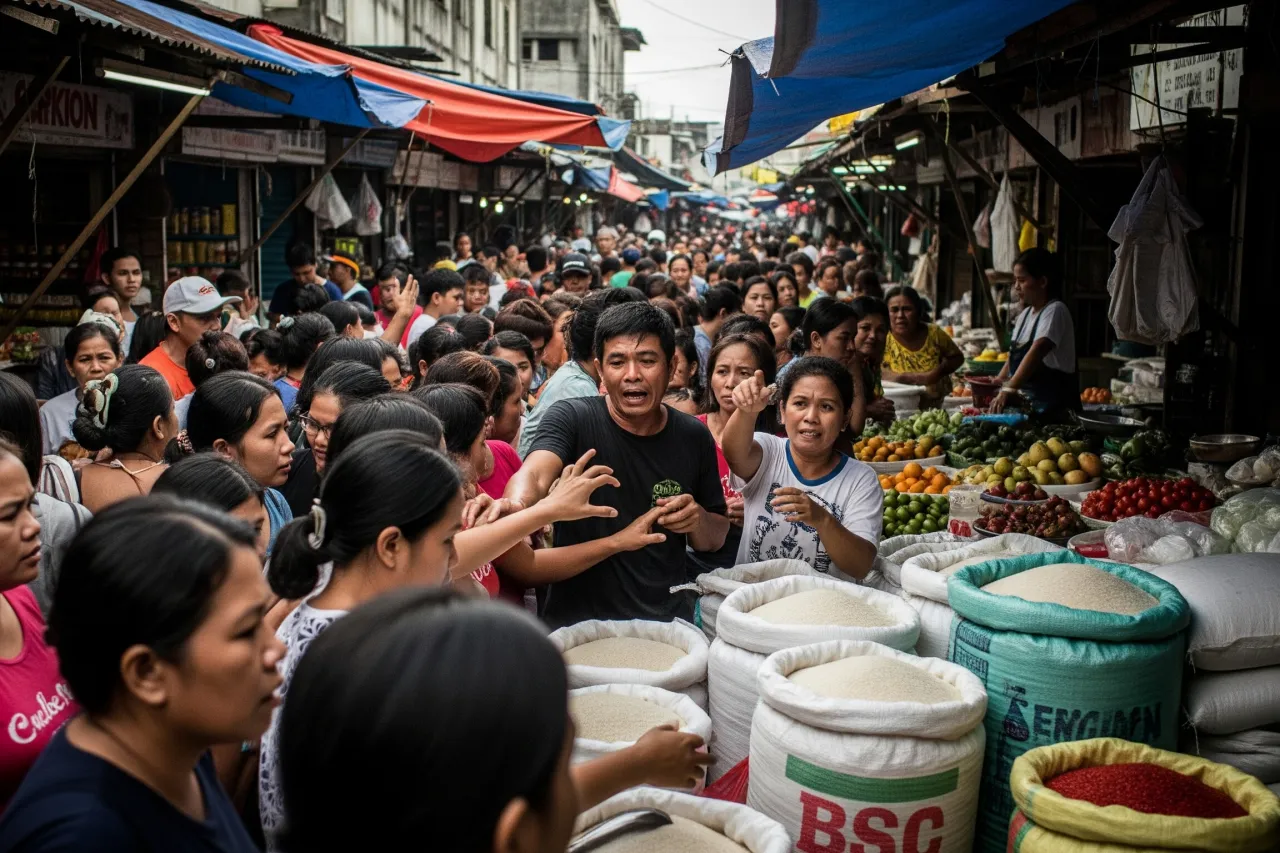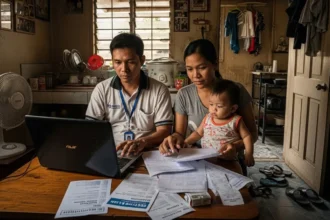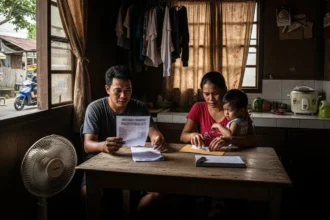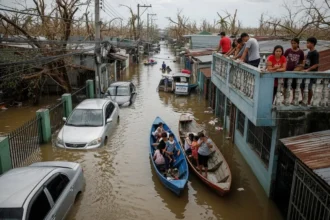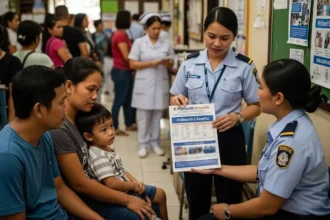“Rice is life.”
We say it half-jokingly – but for most Filipino families, it’s not just a saying, it’s survival. From breakfast silog to midnight lugaw, rice isn’t a side dish – it’s the main character of our every meal.
- Why the Philippines Still Struggles With Rice Supply
- 💰 When Rice Gets Expensive: The Ripple Effect on Everyday Filipinos
- 🌍 Global Pressures and Climate Change: Why Rice Is Getting Harder to Grow
- 💡 Smart Filipino Hacks: How to Cope With Rising Rice Prices
- 🌾 Building a Rice-Secure Future for the Philippines
- 💬 FAQs About the Rice Situation and Food Security in the Philippines
- 💙 The Grain That Holds Us Together
- 🧭 References
But here’s the scary thought: what if one day, the unthinkable happens – the Philippines runs out of rice?
No kanin on the table. No sinangag in the morning. Prices soaring. Imports delayed. Panic spreading faster than the next TikTok trend. Sounds impossible? Maybe. But with rising global prices, shrinking farmlands, and climate shifts hitting harder than ever, it’s a scenario we can’t afford to ignore.
Because when rice becomes scarce, it’s not just the palay farmers who suffer – it’s everyone. The tricycle driver’s lunch, the sari-sari store’s goods, even the simple family merienda – all of it changes.
This isn’t just a food story – it’s a money story.
It’s about how a single grain controls the budget, the market, and the heartbeat of every Filipino home.
So let’s talk about what could really happen if the Philippines runs out of rice – and more importantly, what we can do before that day ever comes.
Why the Philippines Still Struggles With Rice Supply
It’s hard to imagine a country that eats rice three times a day struggling to grow enough of it – but that’s exactly our reality. The Philippines is one of the biggest rice consumers in Asia, yet we remain one of its largest importers.
🌾 The Irony of a Rice-Loving Nation
Every Filipino eats an average of 110 kilograms of rice per year, according to the Philippine Statistics Authority (PSA). That’s roughly two cups a meal – breakfast, lunch, dinner. Multiply that by 110 million people and… yeah, that’s a mountain of rice.
But here’s the problem: our farmlands and farmers can’t keep up. Over the years, agricultural land has been eaten up by housing developments, industrial zones, and concrete roads. Floods, droughts, and rising fertilizer costs make it even harder for small farmers to survive.
Meanwhile, the average age of a Filipino farmer? Around 57 years old. And fewer young people are taking their place. “Mababa ang kita, mataas ang pagod,” they say – and who can blame them?
💸 Dependence on Imports
To fill the gap, the Philippines imports millions of tons of rice yearly – mostly from Vietnam, Thailand, and India. It’s a practical short-term fix, but it also makes us vulnerable.
When global rice prices rise – like they did recently when India restricted exports – local prices skyrocket too. A 5-kilo sack that once cost ₱250 can shoot up to ₱350 or more in just weeks. Families feel it immediately. The poorest households, who already spend over half their income on food, take the hardest hit.
Imports keep us afloat, yes – but they also keep us dependent. And dependency, when it comes to food, is a dangerous thing.
🌦️ The Climate Factor
Then there’s climate change – the invisible villain in this story. Typhoons wipe out harvests, while heatwaves dry up irrigation. The El Niño phenomenon can cut rice production by 10–15% in a single season.
Even when the harvest is good, farmers lose income due to fluctuating prices, limited storage, and unfair trading systems. It’s an endless cycle: too much rain, too little support, too many middlemen.
🚜 The Bigger Picture
The truth is, our rice crisis isn’t just about farming – it’s about systems.
- Lack of investment in irrigation and research.
- Weak post-harvest facilities.
- Import policies that favor traders over farmers.
- And a government safety net that often arrives too late.
Filipinos have always been resilient, yes – but resilience can’t fill a rice cooker.
Until farming becomes profitable again, our dependence on imports will continue. And as long as the system favors importers over local growers, we’ll keep calling rice “life” while slowly losing control over our own supply.
Because the real question isn’t “What if we run out of rice?” – it’s “Why do we always feel like we’re about to?” 🍚
💰 When Rice Gets Expensive: The Ripple Effect on Everyday Filipinos
Every Filipino household has one rule: “Basta may kanin, may ulam.”
That’s the foundation of our meals, our moods, and honestly – our sanity. So when rice prices go up, everything else follows.
🛒 The Palengke Reality
Visit any palengke on a payday weekend and you’ll hear it right away –
“Magkano bigas ngayon?” “Aba, ₱55 na per kilo ah!” “Grabe, dati ₱38 lang yan.”
Those few pesos don’t sound like much, but they add up fast. A family that consumes 2 kilos of rice a day now spends around ₱3,000–₱3,500 monthly just on rice – almost half a minimum-wage earner’s salary.
So what happens next? They adjust:
- Less rice, more noodles.
- Smaller portions for baon.
- Sometimes, plain rice with salt or soy sauce for dinner.
It’s heartbreaking, but it’s reality for millions of Filipino families.
🥘 The Domino Effect on Food Prices
Rice isn’t just something we eat – it’s a base ingredient for the entire food chain.
When rice prices rise:
- Carinderias increase their meal prices.
- Sari-sari stores raise the cost of canned goods and noodles.
- Farm feeds become pricier, pushing up the cost of chicken, pork, and eggs.
It’s like dominoes – one grain affects the rest. The tricycle driver’s lunch, the construction worker’s baon, the student’s daily allowance – all take a hit.
💼 The Financial Stress
Rice inflation also changes how we budget.
A ₱500 grocery trip doesn’t go as far as it used to. Families start cutting down on fruits, meat, and even toiletries just to make room for the rice budget.
And that silent stress builds up. Parents worry every time they visit the palengke. Breadwinners feel guilty when their kids ask for extra rice. OFWs send more money just to cover the same monthly groceries.
It’s not just about economics – it’s emotional.
Because when rice becomes expensive, hope starts to feel expensive too.
🧠 The Hidden Cost
And here’s the part we rarely talk about – how food insecurity affects mental health.
Not knowing if you’ll have enough rice for the week? That’s anxiety. Having to stretch your ulam for the third night? That’s quiet exhaustion.
Filipinos joke about it – “kanin pa rin kahit mamahalin” – but behind the humor is fear. The kind that keeps parents up at night, counting coins and calories at the same time.
So when people say “rice crisis,” it’s not just a news headline. It’s the sound of an empty rice cooker in a kitchen somewhere – and the unspoken question every Filipino asks: “Kaya pa ba?” 💔
🌍 Global Pressures and Climate Change: Why Rice Is Getting Harder to Grow
When people hear about “rice shortages,” they often imagine it as a local problem – a supply issue here, a government policy there. But the truth is, what happens to our rice bowl in the Philippines is tied to everything happening around the world.
From heatwaves in India to droughts in Thailand, from global trade wars to oil prices – every grain of rice we eat carries the weight of an entire planet’s problems.
🔥 The Climate Factor
Rice is a delicate crop. It needs just the right mix of water, sunlight, and temperature. Too much rain and it floods. Too much heat and it dies before harvest.
But because of climate change, that balance is falling apart.
- Typhoons are stronger and more unpredictable – one storm can wipe out entire harvests in Central Luzon or Cagayan Valley.
- El Niño seasons dry up irrigation canals, turning once-productive paddies into cracked earth.
- Rising sea levels cause saltwater to seep into farmlands near the coast, poisoning the soil slowly but surely.
Farmers can’t keep up. Even if they plant more, nature is no longer as reliable as it once was.
🚢 The Global Supply Strain
The Philippines isn’t alone in this.
When India – the world’s top rice exporter – limited exports to protect their local supply, it sent a shockwave across Asia. Countries like the Philippines and Indonesia scrambled to secure contracts from Vietnam and Thailand. But with limited stocks, prices surged everywhere.
Add to that:
- Higher oil prices, which raise transport and fertilizer costs.
- Pandemic aftershocks, which disrupted global shipping.
- And geopolitical conflicts like the Russia-Ukraine war that affected grain trade and fuel availability.
It’s a global domino effect – and unfortunately, developing countries like ours are always the first to feel it.
🧑🌾 The Struggle on the Ground
In Nueva Ecija, farmers say their production costs doubled in recent years. Diesel for water pumps, fertilizer, even sacks – everything costs more. Yet the price they sell their palay for often stays the same.
“Pag binenta namin, lugi. Pag tinago namin, sira.”
That’s the painful irony of farming in a climate crisis.
Even government support programs struggle to keep up with the changing weather patterns. Seeds distributed for dry season planting end up wasted because of unexpected rain; flood relief arrives after the harvest is gone.
💔 A Vicious Cycle
The result? Farmers plant less the following year, fearing losses. Yields drop, imports rise, prices climb – and the cycle repeats.
It’s not laziness. It’s exhaustion. Generations of farmers are trying to fight nature with hope and hand tools while the rest of the world moves on with drones and data.
Climate change isn’t some faraway concept – it’s right there in the next sack of rice you buy, in every storm-damaged field, in every bowl of lugaw that costs a little more each month.
And maybe that’s what hurts most – knowing that something so ordinary, so sacred to Filipino life, is now hanging by a thread we can’t even see.
💡 Smart Filipino Hacks: How to Cope With Rising Rice Prices
Let’s face it – we can’t control global prices or weather patterns, but we can control how we adjust at home. When the budget gets tighter and rice gets pricier, Filipinos do what we’ve always done best: make it work.
Here’s how we can stretch every grain, save a few pesos, and still eat well – without feeling like we’re just “tiis lang.”
🍳 1. Stretch the Rice, Not the Wallet
No one wants to say it, but yes – we can stretch rice servings without sacrificing satisfaction.
- Mix with alternatives: Blend rice with corn grits, adlai, or even boiled kamote. It’s cheaper and surprisingly filling.
- Add fiber: Pair rice with vegetables like kangkong, pechay, or munggo to make every serving last longer.
- Use brown or unpolished rice: A bit pricier upfront, but healthier and more filling – meaning you eat less per meal.
Remember, it’s not about eating less – it’s about eating smarter.
🥘 2. Cook Once, Eat Twice
Rice gets expensive when it gets wasted. So:
- Plan meals for the week. Leftover sinangag or adobo can turn into baon wraps, sandwiches, or rice toppings.
- Batch cook. Cook larger portions of rice once a day and store extras properly (in airtight containers or the fridge).
- Reheat the right way. Sprinkle a bit of water before microwaving to bring back the fluff.
Every leftover saved is one less cup wasted – and that adds up fast.
🏷️ 3. Buy Smart and Local
- Buy in bulk when prices dip. Watch palengke prices and stock up during harvest months when rice is cheapest.
- Support local farmers or co-ops. Many areas now have community-supported agriculture programs (CSAs) where you can buy straight from the source.
- Compare rice grades. Well-milled or mixed grains are often cheaper but still taste great once cooked. Don’t fall for “premium” marketing if your budget doesn’t need it.
A little price tracking can save hundreds per month – sulit ‘yan, promise.
💵 4. Budget the “Rice First” Way
Try a reverse budgeting trick – start with essentials like rice before anything else.
Once you’ve secured your food base, it’s easier to adjust the rest.
- Set a fixed rice budget per week and stick to it.
- Buy rice in smaller, sealed packs if you live alone – less chance of spoilage.
- Track spending with a simple notebook or a free budget app.
You’ll be shocked at how awareness alone can cut impulse buys.
🧑🍳 5. Rediscover Old-School Meals
Our lolas had it figured out long before rice inflation existed.
- Lugaw nights: Stretch 1 cup of rice to feed 4 with garlic, onions, and egg.
- Sinangag reimagined: Turn leftover rice into fried rice with scraps of vegetables, tinapa, or sardines.
- Rice-free dinners: Try pancit, sotanghon, or bread-based meals a few times a week.
The key isn’t deprivation – it’s creativity. Filipino households have survived on improvisation for generations. This is just another chapter in that story.
🫶 6. Share and Swap
If you’re part of a neighborhood or barangay chat group, organize rice pooling or palengke runs. Buying wholesale together gets you discounts.
Or trade goods: 2 kilos of rice for vegetables, eggs, or dried fish.
Bayanihan doesn’t just build houses – it feeds people too.
🌱 7. Grow and Store
Even a small balcony garden can help. Grow easy staples like malunggay, kangkong, or okra to reduce grocery costs.
Store rice in sealed containers with bay leaves or garlic cloves to keep pests away naturally.
Every cup saved from spoilage is a win.
Because at the end of the day, Filipinos don’t just survive – we adapt.
Rising rice prices may hurt, but they’ll never erase our creativity, our humor, or our ability to turn “bahala na” into “kaya pa rin.”
🌾 Building a Rice-Secure Future for the Philippines
Every Filipino knows the saying: “Walang kanin, walang buhay.”
But maybe it’s time we turn that into something bigger – “Walang malasakit, walang kinabukasan.” Because food security isn’t just about rice; it’s about responsibility. Ours, the government’s, and the generations after us.
🏛️ 1. Government Action That Reaches the Ground
Big policies mean little if they don’t reach the farmers who wake up before dawn to plant the palay.
We need:
- Better irrigation systems – to stop relying on unpredictable rainfall.
- Affordable fertilizer programs – so farmers can produce more without drowning in debt.
- Fair buying prices for palay – so that when we say “support local,” it actually feeds the people who grow our food.
Laws like the Rice Tariffication Act were meant to stabilize prices, but they also need balance – protecting both the consumer and the farmer. Because one can’t survive without the other.
🌱 2. Empowering the Next Generation of Farmers
We often say “nawawala na ang kabataan sa agrikultura,” and sadly, it’s true. But it’s not because young Filipinos are lazy – it’s because farming rarely feels worth it.
It’s time to make it cool again.
- Promote agri-entrepreneurship – turning farms into sustainable businesses.
- Offer tech training and grants for young farmers using modern tools and drones.
- Feature success stories of agri-influencers and farmpreneurs to prove that farming isn’t backward – it’s the backbone of the future.
Imagine if every student learned how to grow food the same way we teach them how to use Excel. That’s nation-building in its simplest form.
🧑🌾 3. Supporting Local Over Imported
Yes, imports fill the gaps – but too much dependence kills local spirit. Supporting local farmers means more jobs, less vulnerability, and fresher rice on our tables.
Next time you’re at the palengke, ask:
“Local ba ito?”
That small question builds accountability. If millions of us made that a habit, imagine the ripple effect.
🌎 4. Sustainability Starts at Home
A rice-secure future starts in every Filipino household.
- Avoid wasting food – cook only what you need.
- Support barangay-level farming projects and community gardens.
- Store rice properly to prevent spoilage.
- Talk to your kids about where rice comes from – it’s not “instant,” it’s a labor of love.
When we respect what we eat, we respect the people who make it possible.
💬 5. From Crisis to Culture Shift
Maybe the question isn’t “What if we run out of rice?”
Maybe it’s “What if we finally learned to value it enough?”
Every grain tells a story – of farmers under the sun, of families saving every peso, of meals shared in good times and bad. The future won’t be built by fear, but by understanding that food security isn’t a government project – it’s a national mindset.
Because if there’s one thing stronger than our love for rice, it’s our love for each other.
And that’s something the world can’t take away.
💬 FAQs About the Rice Situation and Food Security in the Philippines
1. Why does the Philippines still import rice even if we grow our own?
Because local production isn’t enough to feed everyone. Our farmlands are shrinking, many farmers have retired, and climate change makes harvests unpredictable. Imports help stabilize prices and fill the supply gap, especially during poor harvest seasons. It’s not ideal, but it’s a short-term fix while the government works on improving local productivity.
2. What happens if the Philippines really runs out of rice?
It would trigger a chain reaction – food prices would spike, inflation would rise, and millions of families would struggle to afford daily meals. Carinderias might close, small businesses would suffer, and poverty rates could climb fast. The shortage would also create panic buying, black markets, and political tension. It’s a nightmare scenario – which is why food security must always be a national priority.
3. Why are rice prices increasing in the Philippines?
A mix of factors: global supply issues, higher import costs, and unpredictable weather. Typhoons, El Niño, and rising fuel prices all affect farming costs. When India or Vietnam limits exports, it drives prices up worldwide. Locally, middlemen and logistics costs add more layers, making rice expensive before it even reaches your palengke.
4. How does rice inflation affect Filipino families?
Rice inflation hits the poorest the hardest because food makes up a huge part of their budget. When rice becomes expensive, families sacrifice nutrition – less meat, fewer vegetables, smaller servings. It’s not just hunger; it’s stress, guilt, and mental fatigue from constantly having to stretch every peso. Inflation doesn’t just raise prices – it lowers quality of life.
5. What is the government doing to solve the rice crisis?
The government has programs like Rice Competitiveness Enhancement Fund (RCEF) and NFA buffer stocking, aimed at helping farmers and stabilizing supply. There are also irrigation projects and fertilizer subsidies in select regions. But implementation remains slow and uneven – many farmers still feel left out. Long-term success depends on consistent funding, transparency, and farmer empowerment, not just short-term imports.
6. Can Filipinos survive without rice?
Maybe for a meal or two – but not for long. Culturally, rice is our comfort food, energy source, and identity. But in tough times, we can adapt by mixing rice with alternatives like corn grits, adlai, camote, or saba. These are healthy, local substitutes that stretch the budget while still keeping the Pinoy taste we love.
7. How can ordinary Filipinos help improve food security?
Start small: avoid wasting rice, buy local, and support community gardens. Join or donate to farm co-ops that sell directly to consumers. Share knowledge – teach kids that every grain counts. When millions of households act consciously, it adds up to a national movement for sustainability.
8. What can be done to encourage young Filipinos to become farmers?
We need to make agriculture rewarding again. That means offering scholarships, access to technology, and fair profit systems. Showcasing success stories of young agri-entrepreneurs can help break the stigma that farming is a “poor man’s job.” If we mix tech with tradition, farming could easily become one of the most fulfilling careers in the country.
9. How can I save money on rice without compromising quality?
Buy rice in bulk during harvest season or direct from farmer groups. Store it properly in airtight containers to avoid spoilage and weevils. Mix rice with corn, adlai, or even vegetables to stretch portions. And remember – sometimes paying a bit more for good-quality rice saves more in the long run since it stores and cooks better.
10. What’s the long-term solution to the rice problem in the Philippines?
A real fix means rebuilding trust and investment in agriculture. We need strong farmer support, better irrigation, less dependence on imports, and education programs for sustainable farming. Consumers should also shift to mindful habits – eat what we need, waste less, and value where food comes from. Food security isn’t just a government issue – it’s a shared Filipino mission.
💙 The Grain That Holds Us Together
Rice isn’t just food – it’s memory, culture, and comfort all in one. It’s the smell of garlic in the morning, the steam from a fresh pot at lunch, the laughter around a dinner table after a long day. For Filipinos, rice is more than a meal – it’s a shared story.
But that story is changing. Climate change, global trade, and local neglect have turned something so ordinary into something fragile. Still, if there’s one thing we’ve learned as a nation, it’s that we adapt.
We plant, we save, we share. We turn scarcity into creativity, struggle into solidarity.
So yes, the thought of the Philippines running out of rice is terrifying – but it’s also a reminder: to protect what feeds us, to value what sustains us, and to never take for granted the simple blessing of a warm bowl of rice.
🧭 References
-
PCAARRD/DOST – Food Security Emergency & Rice Market Stabilization
-
Department of Agriculture – Rice Imports Down, Output and Price Updates
-
Department of Agriculture – Rice Output on Track for Record
-
IRDF – Philippines Is a Rice Deficit Country: Policy Challenges and Solutions
-
Context News – From Farmers to Importers: Rice Growing Challenges
-
Asia Foundation – The Case of the Philippine Rice Sector
-
IRRI Books – Why Does the Philippines Import Rice?



